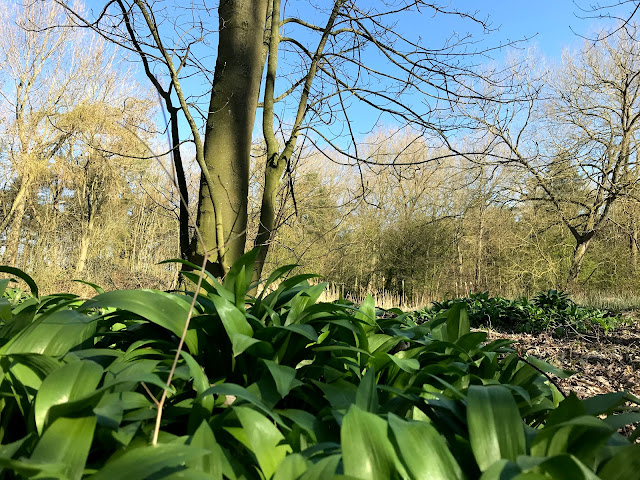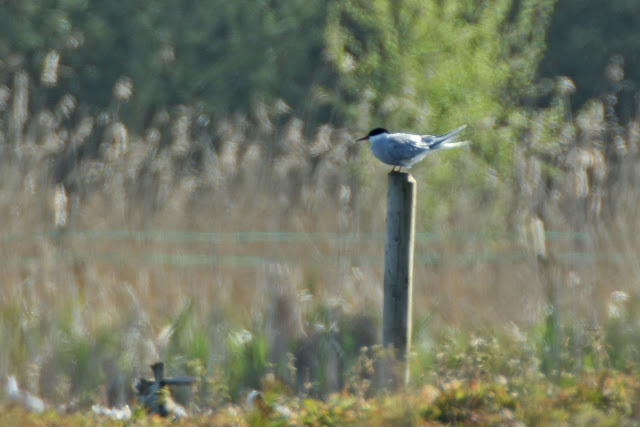So what happened whilst humans were out the way?
Whilst I'd like to say I was at Tophill revelling in a private reserve on a daily basis there has been plenty more to attend to elsewhere in the region - and to be honest Tophill Low has been largely blissfully quiet so at some stages the wider reserve was left to itself for weeks at a time with only quick checks.
Unfortunately we missed out on all the best bits of spring - the first signs such as wild garlic in D woods:
Oystercatchers returned to site on March the 25th:
Reed buntings were plentiful and continue to be actively around site now:
The marshes were refilled at this time to strand islands from predators and kill off vegetation:
Nice to see water vole droppings in South Scrub still:
Barn owls in the boxes at North Scrub. Unfortunately it seems to have been a poor year for them with a bust following a boom in voles last year - likely also due to the wet conditions flooding them out.
Meanwhile the stoats moved into the reception hide; We're not sure where they got in but were using the floor to commute around emerging in the cctv cabinet:
Meanwhile kingfishers returned to nest outside McBean hide - perhaps fortunate we were on lock down as social distancing would have been an unlikely prospect based on 2018:
Kestrels too seem to have fared the same as barn owls with no breeding but a constant presence:
Yellow archangel:
Pussy willow:
Marsh harriers became more and more evident around site - seemingly peaking at 4 pairs active:
Last of the wintering redshanks joined by a flash ruff on April 9th:
First of the marsh frogs not long after:
Nice to see lords and ladies becoming established in the reserve woodlands:
Not what we were hoping to see on the osprey platform - a pair of egyptian geese that were subsequently reported all around the upper reaches of the Hull:
Due to the quiet nature of the site gadwall started nesting on the reception hide pond:
Marsh harriers aplenty; these the North Marsh birds that bred within yards of the hide:
Kingfishers doing their thing at Hempholme; Ultimately we're unsure if they were successful - but there are certainly plenty around the site as is usual for this time of year:
First yellow wags through around the 17th April:
Sparrowhawk enjoying spring passage over the res;
First goslings showing the success of the fox fence:
Nice to see a spring passage black tailed godwit:
Redshank:
House Martin on the 17th April:
Springtime pond:
Amy was lucky enough to be on site during the spring arctic tern movement with 5 birds through on D res in late April:
One of the grey herons - loads of activity in the burgeoning heronry in D woods. We never determined just how many active nests there were. Unfortunately species 272 more than likely eluded us; the predicted squacco heron was seen south of Tophill flying north and later was seen around Bethell's Bridge and as such was almost certainly present - but seen by no one:
Common buzzards likely bred in at least one site on the reserve this year - a regular presence for the first time again likely due to lack of people:
The first swift of 2020 on the 27th April:
More marsh frog:
Common whitethroat on east scrub:
Spring snipe:
Common terns too on the 27th and seemingly bred on South Marsh East:
Willow warbler:
Marsh harrier causing chaos in the gull colony - where at least 45 pairs bred this year:
Shelduck too but seemingly no chicks this year:
Common sandpiper on the 1st May
Bad weather put down good numbers of yellow wags:
And brought in many hundreds of sand martins and swallows:
The belted galloways returned to Hempholme Meadow:
The sand martin colony has been spectacular this year and is well worth a look with reportedly around 50% of holes occupied. However on my 8th May visit there were none about; this was why:
Hairy dragonfly:
Harriers as ever:
Building numbers of goslings showing the success of the fox fence:
Opportunity lost; Marsh harriers eye to eye at the Izzard hide:
Oystercatchers - likely hatched young but were likely predated as below:
A lone mediterranean gull in the colony - one for the future?
Terns a familiar feature though:
Lapwings too certainly attempted to nest:
But these characters were a continuous presence:
The interspecies pair partnered up gain to make more fake barnacle geese to confuse visitors...
Lapwing:
Equally good numbers of greylags on Watton NR:
By this stage it hadn't rained for weeks and the site was drier than we expect in September:
And becoming ever wilder:
First mallard broods:
Picnic area going back to nature:
Foxgloves:
Path disappearing:
Bee orchid on O res:
South Marsh East vegetating up:
Lone little gull on June 4th:
Lingering teal:
Nice to see a pair of shoveler - but no young logged:
Whilst we've sorted the fox predation with high levels of hatching, chicks still seemed scant - this would likely explain why - the marsh appears to have become something of a buzzard take away with them using the shelter belt west of the marsh as a vantage point:

Mute swan fared better though with seemingly 6 cygents maturing:
Despite the lesser black backed's also looking for a meal:
So there we go;
In recent days we've had 4 green sandpiper, common sandpiper and little ringed plover so autumn wader passage is well underway and the marsh strimmed and ready to go with new mud ready:
So here's to a better latter half of the year...
In case you haven't seen the guide to the new access setup due to COVID there's a handy explanatory video
here.























































































































